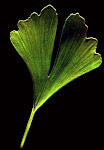New Zealand Tree Crops Association
Ginkgo, a Potential New Crop
by Eric Cairns
When researching alternative or new horticultural crops for NZ, one may be surprised to find how many of them are actually very old or established crops somewhere else. Consider figs, pine nuts or pomegranate. These are crops of old world civilisations of Europe and Asia. They grow well enough in New Zealand, but are not yet common here.
Ginkgo is another old world crop. The Chinese have cultivated it for the nuts for at least 4000 years. Ginkgo is probably extinct in the wild and is said to have been rescued by Chinese monks who attached religious significance to it.
About 200 million years ago, trees closely resembling modern Ginkgo were the dominant plant species on earth. Early European taxonomists believed that this ancient order of plants had died out until western explorers discovered Ginkgo growing in Chinese temple grounds.
Ginkgo leaf extract has traditionally been used by the Chinese for medical conditions such as asthma, circulatory disorders, eye ailments, headaches, haemorrhoids and impotence. Modern western medicine recognises the beneficial effects that Ginkgo extract has on blood circulation and related degenerative conditions such heart disease, dementia, alzheimers disease, vertigo, short term memory loss, depression, tinnitus, headaches, dizziness, blood circulation to the limbs etc. Ginkgo extracts reduce the stickiness of the blood, hence improving blood flow. The antioxidant properties of flavanoids in general may be responsible for the protective effects against other degenerative diseases.
While the popular reputation of ginkgo is to assist students doing exams, the truth is that it is unlikely to assist healthy young minds. But the manufacturers of the product claim benefits for people over forty. The cure is not instant. It often takes 4-6 weeks to show initial results, with cumulative effects building for 6 months.
Since the 1980s, Western pharmaceutical industries took an interest and ginkgo plantations were established in France and the USA, specifically for leaf production. Later China also established large plantations for leaf production. Pharmaceutical companies extract the leaves to produce purified concentrates rich in flavanoids and terpenes. It is said that herbal teas made from ginkgo leaves are not strong enough to produce beneficial effects. Such teas would also contain tannins and allergens which could cause side effects.
China now harvests about 3000 tons of dried leaf and a further 4000 tons is harvested from other world supplies. Perhaps a ginkgo leaf industry could be profitably established in NZ, as the trees do grow well here, and our high ultraviolet light intensities are likely to induce higher flavanoid levels than in the northern hemisphere.
Leaf harvest would require low bushes and mechanical or hand harvesting. Such a plantation would look like a corn field or perhaps a series of low hedgerows. Nut production, on the other hand, requires tall mature trees, and allows the opportunity to appreciate the aesthetic beauty of these ancient trees in a park or forest setting. Perhaps this the ideal crop for a lifestyle farm?
Seedling trees have good apical form and eventually grow to around 25 metres tall. The form of grafted trees depends on whether the scion wood was taken from the top or side growth of the parent tree. The graft continues with the form when the bud first developed. Hence many grafted trees lack the classic pyramidal shape and may need staking to straighten the main leader. All however, produce wonderful butter yellow autumn foliage and lime green spring growth (trees are deciduous). The leaves are fan shaped and reminiscent of a maidenhair fern, so the tree is sometimes called the maidenhair tree.
One of the draw backs is that the ginkgo fruit (like a plum) has a strong smell of butyric acid (like vomit), and some westerners may object to an orchard near their house or in public access places. Hence, many public place ginkgoes are grafted males.
Harvesting the plum like fruit may require the use of protective clothing. Not only is the flesh smelly, some people are also allergic to it. The fleshy fruit may be fermented before being washed off the nuts.
For all that, the nuts are clearly in strong demand by some Asian communities, and the few park trees in NZ which produce nuts are in eager demand. There is probably a substantial local ethnic market for the nuts. Chinese and Japanese communities may know ginkgo as white nuts (yin-kuo) or silver apricot (yin-hsing). The are usually cooked by roasting, and some reports liken the flavour to almonds.
There is likely to be an export market, at least to Japan, but no specialised industry infrastructure exists here. A lack of industrial infrastructure need not be a major barrier, as no doubt export companies would be keen to include ginkgo with mixed consignments of other produce. Best prices, however, come with regular supply and established reputation; not easy for the small grower. The nuts are perishable (and therefore, fresh NZ nuts would not compete with northern hemisphere product).
Trees are easy to graft, but no improved female cultivars for nut production are known in NZ. Seedlings are readily available from wholesale nurseries, but could take over 20 years to bear nuts, and about half of the trees would be unproductive males. Grafted trees are quicker, but are still said to take at least 7 years before cropping begins. Suggested spacings are at 8 metre centres, with one tree in 9 being a male pollinator. At least two major NZ mail order nurseries sell grafted female ginkgo trees.
The NZ Tree Crops Association is researching ginkgo nut production with some small trial orchards. We would be keen to hear of any superior female nut trees in NZ for inclusion in our trials.
(Izvor: http://www.treecrops.org.nz/knowl/archives/cairnse/ginkgoce.html)












